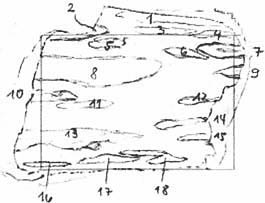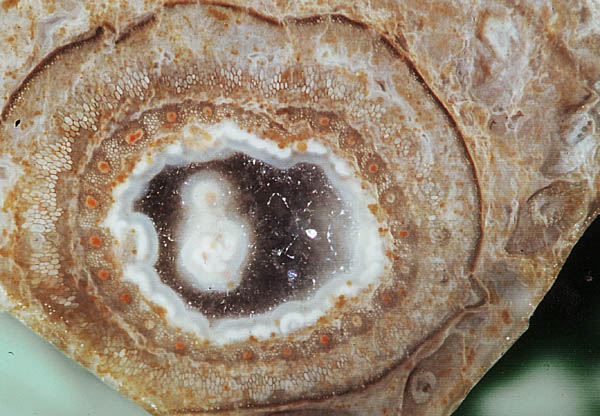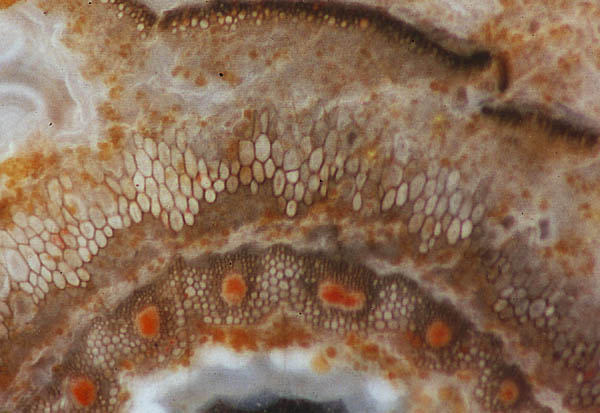Calamite offspring
The Palaeozoic horsetail trees known as calamites [1] are commonly
found as stem casts [2], pith casts, or as compressions of their hollow
stems, branches and leaves in sediment rocks between coal seams [3].
Less common are thoroughly silicified specimens,
notably those of species with solid wooden stems superficially
resembling coniferous tree trunks of potentially big size ([4], see Fossil
Wood News 15).
In the following, attention is drawn to the less conspicuous tiny
calamite
offspring which apparently covered suitable spots of soil or mud in
great numbers. In the cherts of the Lower Permian Döhlen basin,
calamites are found among the remains of tree ferns as a rarer
component of the silicified swamp matter, or as uniform stands of
juvenile plants lying flattened and
aligned as if upset
by a flash flood (Fig.1).

 Fig.1:
Chert face with 18 or more
cross-sections of small calamites of various size on 20cm2,
lying aligned and
flattened.
Fig.1:
Chert face with 18 or more
cross-sections of small calamites of various size on 20cm2,
lying aligned and
flattened.
Width of the picture (= frame in drawing) 5cm.
Fig.2 (below):
Tiny calamite in chert, silicified while in upright position. Note the
cross-sections of upright setaceous leaves keeping close to the stem
(on the right).
Stem diameter 5mm.

Well preserved small calamites seem to be very
rare in the cherts.
The one in Fig.2 is a unique find. It became silicified while being
inundated in swamp water, judging from tree fern pinnules and moult
fragments of the aquatic crustacean Uronectes in the
same sample.
It has to be mentioned that Fig.2 had been interpreted as a calamite
branch
cross-section [5]. The alternative interpretation as a small stem as
proposed here is based on the following observations:
The object is standing upright in the chert layer. Its length does not
much exceed 3cm. The leaves are setaceous and stiff upright, gradually
converging towards the top.
This gives rise to the following thoughts: Calamite branch fragments
would
most probably be lying prostrate in the chert layer, be longer, and
have broad outspread
leaves, which justifies the tentative assumption that the present
specimen is no such.
Fig.3 (below): Tiny calamite,
detail of Fig.2.
Note the beginning growth of wood with small cells outward from every
red spot, the onset of the primary
"pith rays" in between, the distinctly seen cortex tissue, and the
slightly displaced epidermis. Width of the picture 2.5mm.
Annotation 2016: A
detail of Fig.3 is shown in [6], Fig.75a, too small by a factor 2.8.

The central pith and the protoxylem strands have
vanished.
The cavities left by the latter have become stained red with hematite.
The red spots mark the apex of the wood wedges which would have grown
if the plantlet had lived on. Parenchymatic tissue between the spots
would have grown into "pith rays". Remarkable is the preservation of
the cortex tissue with its large cells. The outermost sheath with the
epidermis appears detached and slightly displaced.
Photographs: Figs.2,3 by
M. Barthel. The
samples are kept in the own collection.
Fig.1: Bu4/59.3, found in 1995 on the property of F.+ U. Lippert, Freital-Burgk,
Bernhardts Weg 25.
Fig.2: Bu7/46.1, found in 2000, Freital-Kleinnaundorf, Kohlenstr.,
type locality of the Scolecopteris
tree fern. Döhlen basin near Dresden, Saxony.
H.-J. Weiss
2012
[1] T.N. Taylor
et al.: Paleobotany. Elsevier 2009
[2] W.A. DiMichele,
H.J. Falcon-Lang:
Calamitalean "pith casts" reconsidered. Rev. Palaeobot.
Palyn. 173(2012), 1-14.
[3] W. Reichel,
M. Schauer: Das Döhlener Becken bei Dresden. Bergbau in
Sachsen, Band 12. Freiberg 2006.
[4] R.
Rößler, R. Noll: The largest known anatomically preserved
calamite, an exceptional find from the petrified forest of Chemnitz.
Rev. Palaeobot. Palyn.
140(2006), 145-62.
[5] M.
Barthel: Paläobotanische Aspekte des Döhlen-Beckens.
Veröff. Museum für Naturkunde Chemnitz 27(2004), 17-28.
[6] M.
Barthel: Die Rotliegendflora der Döhlen-Formation.
Geologica Saxonica 61 (2) 2015, 105-238.
|
 |
 10 10 |

 10
10
 Fig.1:
Chert face with 18 or more
cross-sections of small calamites of various size on 20cm2,
lying aligned and
flattened.
Fig.1:
Chert face with 18 or more
cross-sections of small calamites of various size on 20cm2,
lying aligned and
flattened. 


 10
10